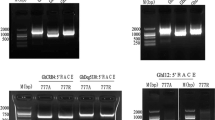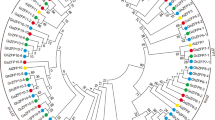Abstract
A new member of the WD repeat protein family, named GhWD40, was cloned from a near-isogenic line for glands in cotton. It has 2629 bp cDNA and a complete opening reading frame (ORF) of 1239 bp, containing the initial code (ATG) and terminal code (TAG); there is a 1061 bp non-coding sequence at the 5′-end, and a 329 bp non-coding sequence at the 3′-end, including the poly(A) sequence (accession number: JN714279). The predicted protein of the complete ORF comprised 412 amino acids with a calculated molecular mass of 47.1 kDa and an isoelectric point of 8.88. Protein domain scanning showed that the novel protein has five wd40 motifs and belongs to the WD40 family. From a search for GhWD40 cDNA and amino acid sequences in the database, it has 77% sequence identity and was 90% sequence positive with the WD-40 repeat protein from Trifolium pratense (accession number BAE71307.1), and 80% sequence identity and 89% sequence positivity with the ribosome biogenesis protein bop1 from Ricinus communis (accession number XP 002529002.1). We propose that GhWD40 may play the same role as bop1. In addition, expression of GhWD40 in near-isogenic lines 11 and 3 (with and without glands, respectively) was studied by quantitative RT-polymerase chain reaction, and the level in near-isogenic line 11 was higher than that in near-isogenic line 3, suggesting that GhWD40 may be related to gland formation.
Similar content being viewed by others
Abbreviations
- ORF:
-
opening reading frame
- ATG:
-
initial code
- TAG:
-
terminal code
- RACE:
-
rapid amplification of cDNA ends
- CAP:
-
Contig Assembly Program
References
Ajay A.V. & Narendra T. 2006. Stress responsive DEAD-box helicase: A new pathway to engineer plant stress tolerance. Biology 84: 150–160.
Baum S., Bittins M., Frey S. & Seedorf M. 2004. Asc1p, aWD40-domain containing adaptor protein, is required for the interaction of the RNA-binding protein Scp160p with polysomes. Biochem. J. 3: 823–830.
Benedict C.R., Lu J.L., Pettagrew D.W., Liu J., Stipanovic R.D. & Williams H.J. 2001. The cyclixation of farnesyl diphosphate a.d nerolidyl diphosphate by a purified recombinant delta-cadinene synthace. Plant Physiol. 125: 1754–1765.
Bertrand J.A., Sudduth T.Q., Condon A., Jenkins T.C. & Calhoun M.C. 2005. Nutrient content of whole cottonseed. J. Dairy Sci. 88: 1470–1477.
Cai Y.F., Chen M., Sun Q., Xie Y.F., Li S.W., Jiang M.F., Mo J.C., Yuan Y.L., Shi Y.Z., Jiang H.Z., Pan Z., Gao Y.L., Ye P.S. & Zeng H.L. 2009. Profiling gene expression during gland morphogenesis of a glanded and a glandless upland cotton. J. Plant Biol. 52: 1226–9239.
Du L., Ge F., Zhu S. & Parajulee M.N. 2004. Effect of cotton cultivar on developmentand reproduction of Aphis gossypii (Homoptera: Aphididae) and its predator Propylaea japonica (Coleoptera: Coccinellidae). J. Econ. Entomol. 97: 1278–1283.
Duan H.Y., Li F.G., Wu X.D., Ma D.M., Wang M. & Hou Y.X. 2006. The cloning and sequencing of a cDNA encoding a WD repeat protein in cotton (Gossypium hirsutum L.). DNA Seq. 17: 49–55.
Gerasimidis K., Fillou D.T., Babatzimcpoulou M., Tassou K. & Katsikas H. 2007. Preparation of an edible cottonseed protein concentrate and evaluation of its functional properties. Int. J. Food Sci. Nutr. 58: 486–490.
Heywood R. 1988. The toxicology of gossypol acetic acid and (−)-gossypol. Contraception 37: 185–190.
Humphries J.A., Walker A.R., Timmis J.N. & Orford S.J. 2005. Two WD-repeat genes from cotton are functional homologues of the Arabidopsis thaliana TRANSPARENT TESTA GLABRA1 (TTG1) gene. Plant Mol. Biol. 57: 67–81.
Luo P., Wang Y.H., Wang G.D., Essenberg M. & Chen X.Y. 2001. Molecular cloning and functional identification of (+)-deltacadinene-8-hydroxylase, a cytochrome P450 mono-oxygenase (CYP706B1) of cotton sesquiterpene biosynthesis. Plant J. 28: 95–104.
Lusas E.W. & Jividen G.M. 1987. Glandless cottonseed: A review of the first 25 years of processing and utilization research. J. Am. Oil Chem. Soc. 64: 839–854.
Martin G.S., Liu J., Benedict C.R., Stipanovic R.D. & Magil C.W. 2003. Reduced levels of cadinane sesquiterpenoids in cotton plants expressing antisense (+)-δ-cadinene synthase. Phytochemistry 62: 31–38.
McMichael S.C. 1959. Hopi. Cotton, a source of cotton seed free of gossypol pigment. Agron. J. 51: 630.
McMichael S.C. 1960. Combined effects of glandless genes gl2 and gl3 on pigment glands in the cotton plant. Agron. J. 52: 385–386.
Miravalle R.J. & Hyer A.H. 1962. Identification of the Gl2 gl2 Gl3 gl3 genotype in breeding for glandless cottonseed. Crop Sci. 2: 395–397.
Neer E.J., Schmidt C.J., Nambudripad R. & Smith T.F. 1994. The ancient regulatory-protein family of WD-repeat. Nature 371: 297–300.
Sang G.W., Zhang Y., Qi S., Shen K., Lu F., Zhao X., Wang M., Liu X. & Yuan Y. 1980. Chronic toxicity of gossypol and the relationship to its metabolic fate in dogs and monkeys. Acta Pharmacol. Sinica 1: 39–43.
Shandilya L.N., Clarkson T.B., Adams M.R. & Lewis J.C. 1982. Effects of gossypol on reproductive and endocrine functions of male cynomolgus monkeys. Biol. Reprod. 27: 241–252.
Stipanovic R.D., Lopez J.D., Jr. Dowd M.K., Puckhaber L.S. & Duke S.E. 2006. Effect of racemic and (+)- and (−)-gossypol on the survival and development of Helicoverpa zea larvae. J. Chem. Ecol. 32: 959–968.
Strezoska Z., Pestov D.G. & Lau L.F. 2000. Bop1 is a mouse WD40 repeat nucleolar protein involved in 28S and 5.8S RRNA processing and 60S ribosome biogenesis. Mol. Cell Biol. 20: 5516–5528.
Sun Q., Cai Y.F., Xie Y.F., Mo J.C., Yuan Y.L., Shi Y.Z., Li S.W., Jiang H.Z., Pan Z., Gao Y.L., Chen M. & He X.H. 2010. Gene expression profiling during gland morphogenesis of a mutant and a glandless upland cotton. Mol. Biol. Rep. 37: 3319–3325.
Sunilkumar G., Campbell L.M., Puckhaber L., Stipanovic R.D. & Rathore K.S. 2006. Engineering cottonseed for use in human nutrition by tissue-specific reduction of toxic gossypol. PNAS 103: 18054–18059.
Terol J., Bargues M. & Pérez-Alonso M. 2000. ZFWD: a novel subfamily of plant proteins containing a C3H zinc finger and seven WD40 repeats. Gene 260: 45–53.
Townsend B.J., Poole A., Blake C.J. & Llewellyn D.J. 2005. Antisense suppression of a (+)-delta-cadinene synthase gene in cotton prevents the induction of this defense response gene during bacterial blight infection but not its constitutive expression. Plant Physiol. 138: 516–28.
Vaissayre M. & Hau B. 1985. New results on the susceptibility of glandless cotton varieties to phyllophagous insects. Coton et Fibres Tropicales 40: 159–168.
Wang J.Y., Cai Y., Gou J.Y., Mao Y.B., Xu Y.H., Jiang W.H. & Chen X.Y. 2004. VdNEP, an elicitor from Verticillium ahliae, induces cotton plant wilting. Appl. Environ. Microb. 70: 4989–4995.
Weinbauer G.F., Rovan E. & Frick J. 1983. Toxicity of gossypol at antifertility dosages in male rats. Andrologia 15: 213–221.
Xie Y.F., Cai Y.F., Jiang H.Z., Xia Y.X., Sun Q., Li S.W. & Wang B.C. 2008. Cloning and characterization of WD40 gene in cotton. Agri. Sci. Technol. 9: 60–63.
Xu Y.H., Wang J.W., Wang S., Wang J.Y. & Chen X.Y. 2004. Characterization of GaWRKY1, a cotton transcription factor that regulates the sesquiterpene synthase gene (+)-d-Cadinene synthase-A. Plant Physiol. 135: 507–515.
Zhang X.L., Jin L. & Zhang T.Z. 2001. A new upland cotton cultivar with glanded plant and low gossypol content seed. Sci. Agric. Sin. 34: 564–567.
Zhu M.X., Li Y.Q. & Dai X.F. 2004. Gossypol gland and gossypol biosynthesis and molecular breeding of low gossypol cotton. Fenzi Zhiwu Yuzhong (Molecular Plant breeding) 2: 307–312.
Zhu Y., Wang Y., Xia C., Li D., Li Y., Zeng W., Yuan W., Liu H., Zhu C., Wu X. & Liu M. 2004. WDR26: A novel Gbetalike protein, suppresses MAPK signaling pathway. J. Cell Biochem. 3: 579–587.
Author information
Authors and Affiliations
Corresponding author
Rights and permissions
About this article
Cite this article
Sun, Q., Cai, Y., Zhu, X. et al. Molecular cloning and expression analysis of a new WD40 repeat protein gene in upland cotton. Biologia 67, 1112–1118 (2012). https://doi.org/10.2478/s11756-012-0103-0
Received:
Accepted:
Published:
Issue Date:
DOI: https://doi.org/10.2478/s11756-012-0103-0




